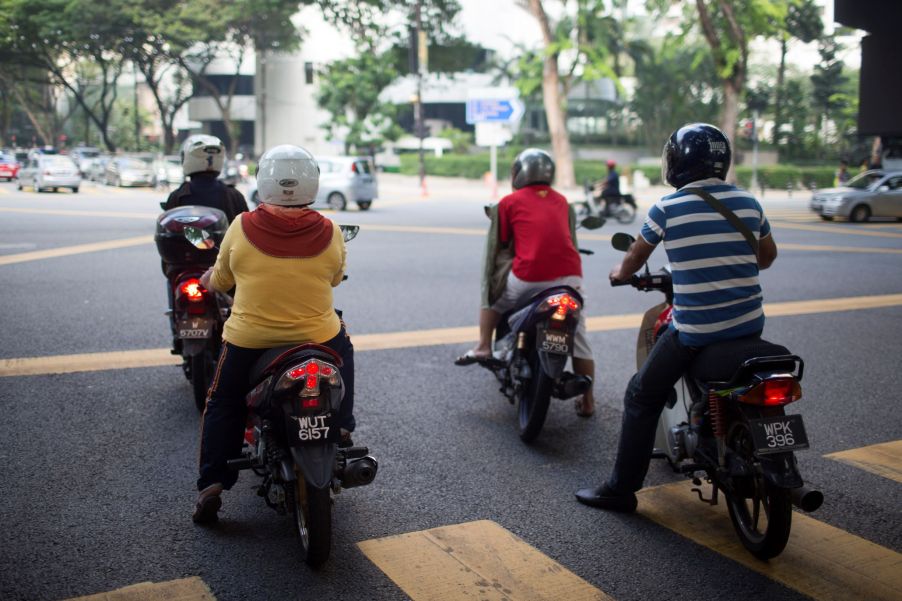
Can You Legally Run Long Red Lights on a Motorcycle?
It’s a tale riders have experienced time and again. You’ve got your boots and all your other gear on for a lovely day on your motorcycle, but you get stuck at a red light. And it just takes forever to change. No, it’s not because the traffic lights are broken, but because their sensors might not be picking up that you’re there. But as annoying as a long red light can be, can motorcycle riders run them without legal repercussions?
Traffic light sensors often can’t detect motorcycles

No, flashing your headlights doesn’t make the light turn green. But there are traffic light sensors that signal the, well, signals to change. And unfortunately, the most common kind doesn’t always sense the presence of two-wheeled vehicles like motorcycles and bikes.
There are several different kinds of traffic light sensors used on modern roads. Some are essentially video cameras, Automate Systems explains, while others use microwaves to ‘read’ the road. And incidentally, radar detectors can theoretically pick up the latter occasionally.

But the most commonly-seen traffic light sensors rely on pavement-embedded induction loops. You know those strange rectangles and lines cut into the road by intersections? Those aren’t scales, as some people claim, Motorbike Writer reports, but induction loops. They’re wires that send out an electromagnetic field, and when a vehicle passes through it, it produces an electrical signal. The sensors pick this up and pass the information to the nearby computer controlling the traffic lights, the US DOT explains.
The induction-loop traffic light sensors work well for large road-going vehicles like cars and trucks. That’s because they both have large quantities of metal spread out over a large area, RideApart explains. However, in terms of conductive material mass, motorcycles and bicycles come up short in comparison, RevZilla explains. Plus, they’re significantly narrower, which exacerbates the problem, RideApart reports. And because the system doesn’t get a signal, the red light doesn’t change.
When can you run a red light on a motorcycle?
Before you try to run a long red light on your motorcycle, there are a few things you can try. First, make sure your bike is positioned as close to one of the induction wires as possible. If you can, try to stop right on top of the main loop, RevZilla reports. And if there are cars behind you, try to safely get them to move forward so they trigger the traffic light sensors.
But if it’s just you on your motorcycle at a long red light, you don’t necessarily have to just wait it out. A handful of states have laws in place that allow riders to, if necessary, run red lights that refuse to change, Cycle World reports.
Specifically, these states:
- Arkansas
- Idaho
- Minnesota
- Missouri
- Nevada
- North Carolina
- Oklahoma
- South Carolina
- Tennessee
- Virginia
- Wisconsin
- Oregon
- Washington
These laws are often called “dead red” laws or “ride on red” laws, depending on the state. And each state has its own unique rules, Bike Bandit reports.
For example, Illinois, where I live, allows motorcycles and cyclists to treat long red lights as a four-way stop and “proceed with caution,” Patch reports. However, the light has to be red for at least 120 seconds, and it doesn’t apply “within municipalities of over 2,000,000 people,” the American Motorcyclist Association reports. So, while I could run a long red light on my motorcycle around the University of Champaign-Urbana, I couldn’t do it in Chicago.
Are there safer alternatives?
Naturally, the idea of running a red light on a motorcycle, even if it’s legal, might sound terrifying for some. After all, motorcycle armor and an airbag jacket only go so far. And what about in places without “dead red” laws?
Besides the options listed above, you could get off the bike and press a nearby crosswalk button. Some of these buttons only change the signal timing, rather than actively changing the light, but it could theoretically decrease your red light wait time.

Another option is to pull a U-turn and find another route, but this depends on several factors. Firstly, do you feel safe doing so? And secondly, are you allowed to do it? Just like the “dead red” laws, this is state- and municipality-dependent, so check up on your local regulations beforehand. But broadly speaking, unless signs explicitly prohibit it, it is a potential alternative to running a red light on your motorcycle.
Speaking of local regulations, though, there is an additional solution to dealing with long red lights on your motorcycle. The induction-loop traffic light sensors have variable sensitivity that gets adjusted every so often, RevZilla reports. If you notice a local traffic signal never seems to see bikes, a local or state government agency can request a sensitivity adjustment. That way, you’ll never have to wait at a long red light when you’re riding your motorcycle.
Follow more updates from MotorBiscuit on our Facebook page.


